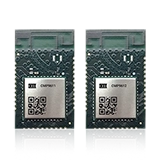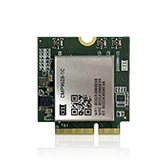Unlocking the Power of Wi-Fi 6: OFDMA, 802.11ax MU-MIMO, and More
When people talk about Wi-Fi 6, they often compare it with Wi-Fi 5 (802.11ac), discussing the higher data rates and blazing speed that Wi-Fi 6 (802.11ax) offers. Yes, theoretically, Wi-Fi 6 will achieve much higher connection rates (up to 9.6Gbps). However, Wi-Fi 6 promises to deliver much more than increased speeds.
Let’s take a look at the evolution of Wi-Fi technology to appreciate the revolutionary leap that Wi-Fi 6 represents. Below is a “Wi-Fi Evolution Timeline” chart showing the progression of Wi-Fi from its inception in 2003 up to the introduction of Wi-Fi 6 in 2019.
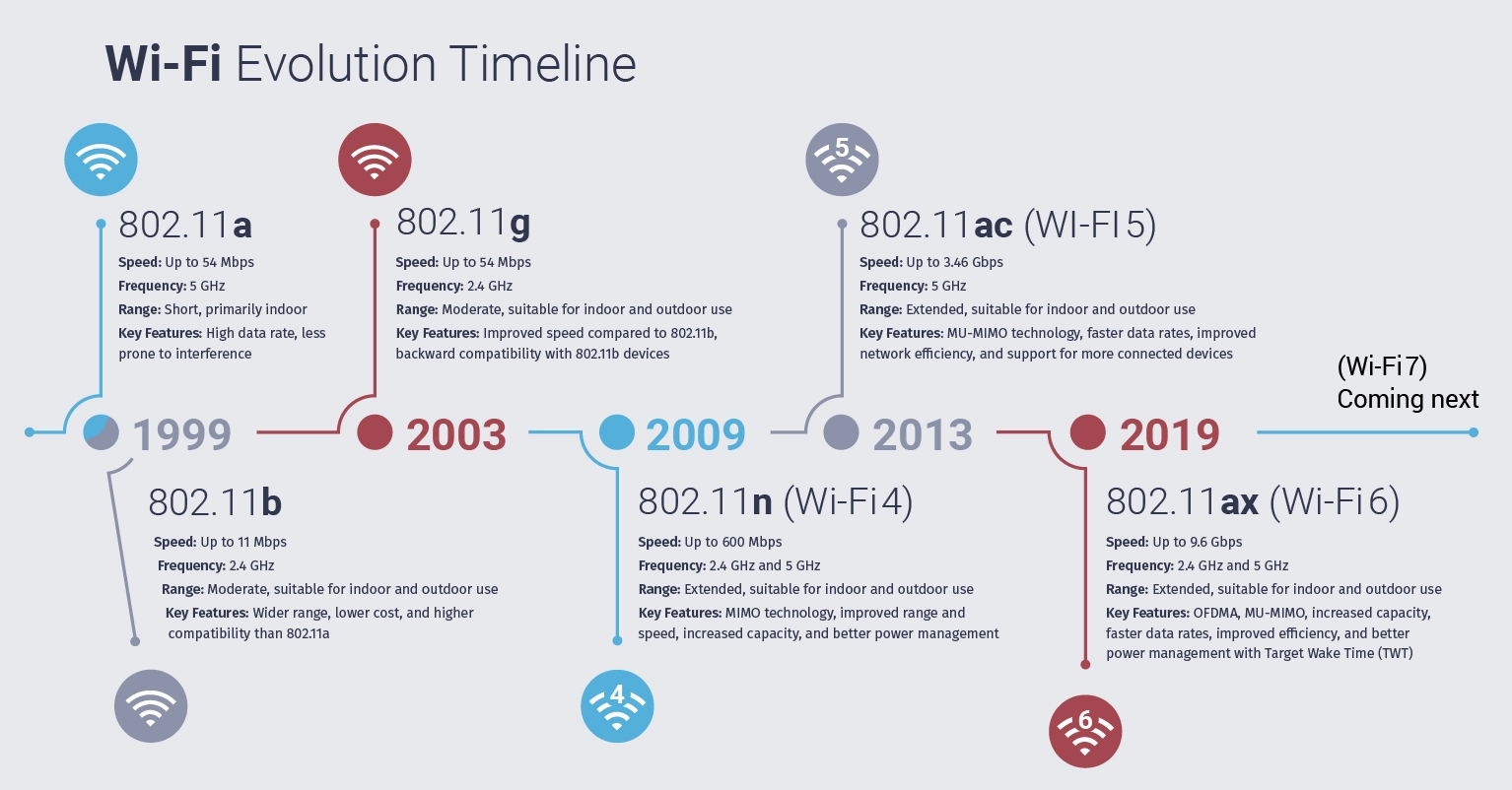
As you can see, Wi-Fi technology has come a long way, and Wi-Fi 6 is the latest step in this ongoing evolution. This blog post will detail the key advantages associated with Wi-Fi 6 networks, while also providing a comparison: Wi-Fi 5 vs Wi-Fi 6.
Greater Network Capacity and Efficiency in Dense Environments
One key difference between Wi-Fi 5 and Wi-Fi 6 is the improved network capacity and efficiency in dense environments. This is particularly important for tackling network congestion, a common issue in crowded areas. Features such as MU-MIMO, OFDMA/802.11ax MU-MIMO, and Basic Service Sets, like Spatial Frequency Re-use, contribute to this improvement.
To better visualize the differences, let’s compare Wi-Fi 5 and Wi-Fi 6 side-by-side in the table below:
| Features | Wi-Fi 5 (805.11ac) | Wi-Fi 6 (802.11ax) |
|---|---|---|
| Release Year | 2013 | 2019 |
| Frequency Bands | 5 GHz | 2.4 GHz and 5 GHz |
| Max Theoretical Data Rate | Up to 3.46 Gbps | Up to 9.6 Gbps |
| Spatial Streams | Up to 8 | Up to 8 |
| Channel Bandwidth | 20 MHz, 40 MHz, 80 MHz, 160 MHz | 20 MHz, 40 MHz, 80 MHz, 160 MHz |
| Modulation Scheme | 256-QAM | 1024-QAM |
| MIMO | SU-MIMO (Single User MIMO) | MU-MIMO (Multi-User MIMO) |
| Security | WPA 2 | WPA 3 |
| OFDMA | No | Yes |
| Target Wake Time (TWT) | No | Yes |
- As shown in the table, Wi-Fi 6:
- has a higher maximum theoretical data rate
- Offers both 2.4 GHz and 5 GHz frequency bands
- Includes advanced features like OFDMA and TWT
- Uses Multi-User MIMO technology
All of these contribute to its superior performance and efficiency.
Key Features
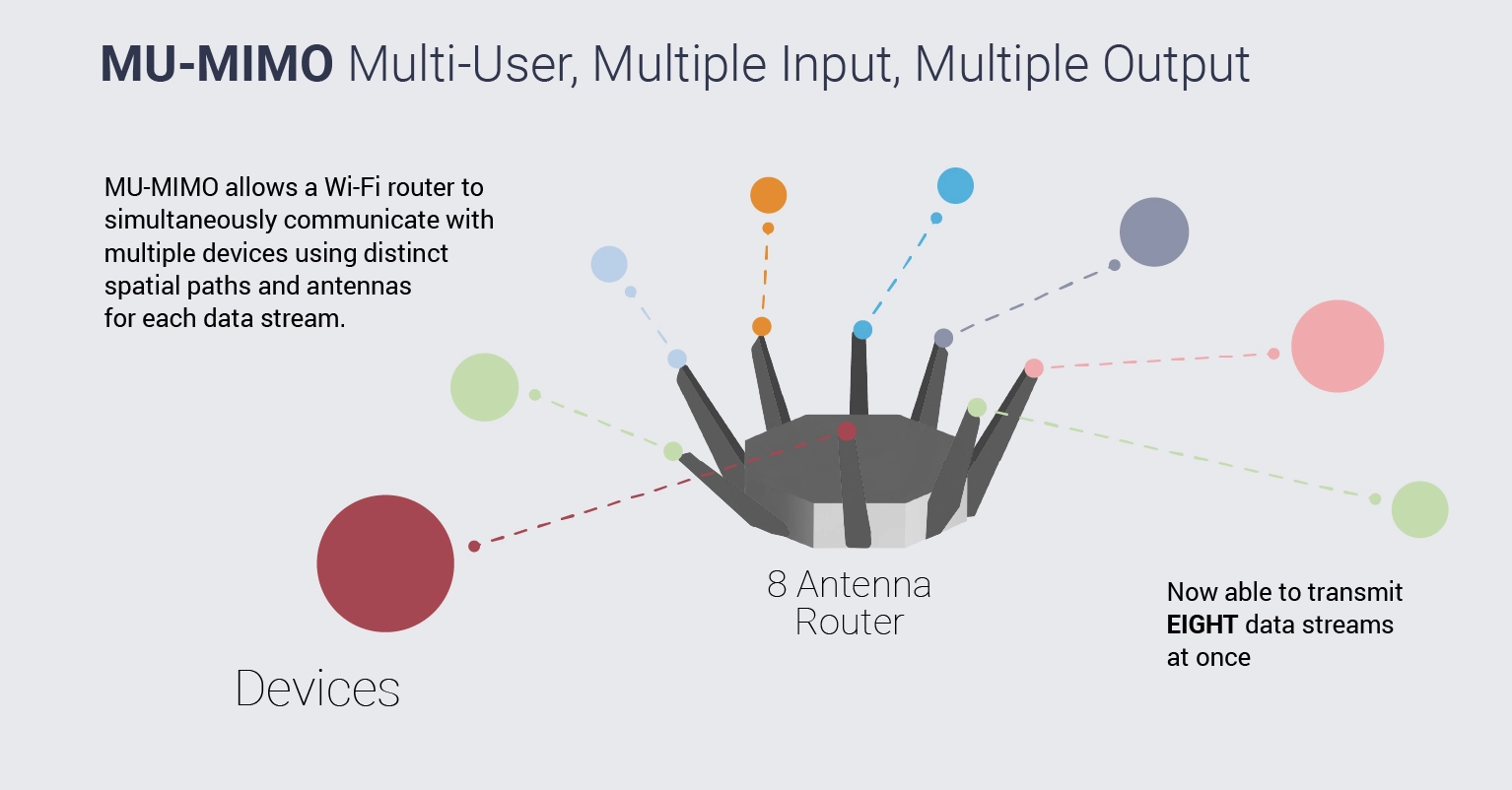
MU-MIMO: Wi-Fi 6 has expanded MU-MIMO to allow for routers to talk with up to eight devices simultaneously.
OFDMA: One transmission can provide data to multiple devices at once. This is accomplished by slicing the few big existing Wi-Fi channels into much smaller ones called Resource Units.
1024-QAM: This allows for more data to be packed into each transmission for greater throughput and improving spectral efficiency.
160MHz Channel Bandwidth combined with MU-OFDMA: This improves efficiency by reducing packet airtime and enabling packet transfer of different sizes from multiple clients simultaneously.
Basic Service Sets such as Spatial Frequency Re-use: This allows for utilizing channels in a more coordinated and efficient manner.
Additional 6GHz Spectrum for Wi-Fi 6E networks: Wi-Fi 6E introduces an additional 6GHz spectrum, making available an additional 1.2GHz of clear spectrum in certain regions. This feature further sets Wi-Fi 6E apart from Wi-Fi 6 and Wi-Fi 5.
Lower Power Consumption
With Target Wake Times (TWT) and efficient use of bandwidth, Wi-Fi 6 consumes less power compared to Wi-Fi 5, making it an excellent choice for IoT devices and those looking for power conservation.
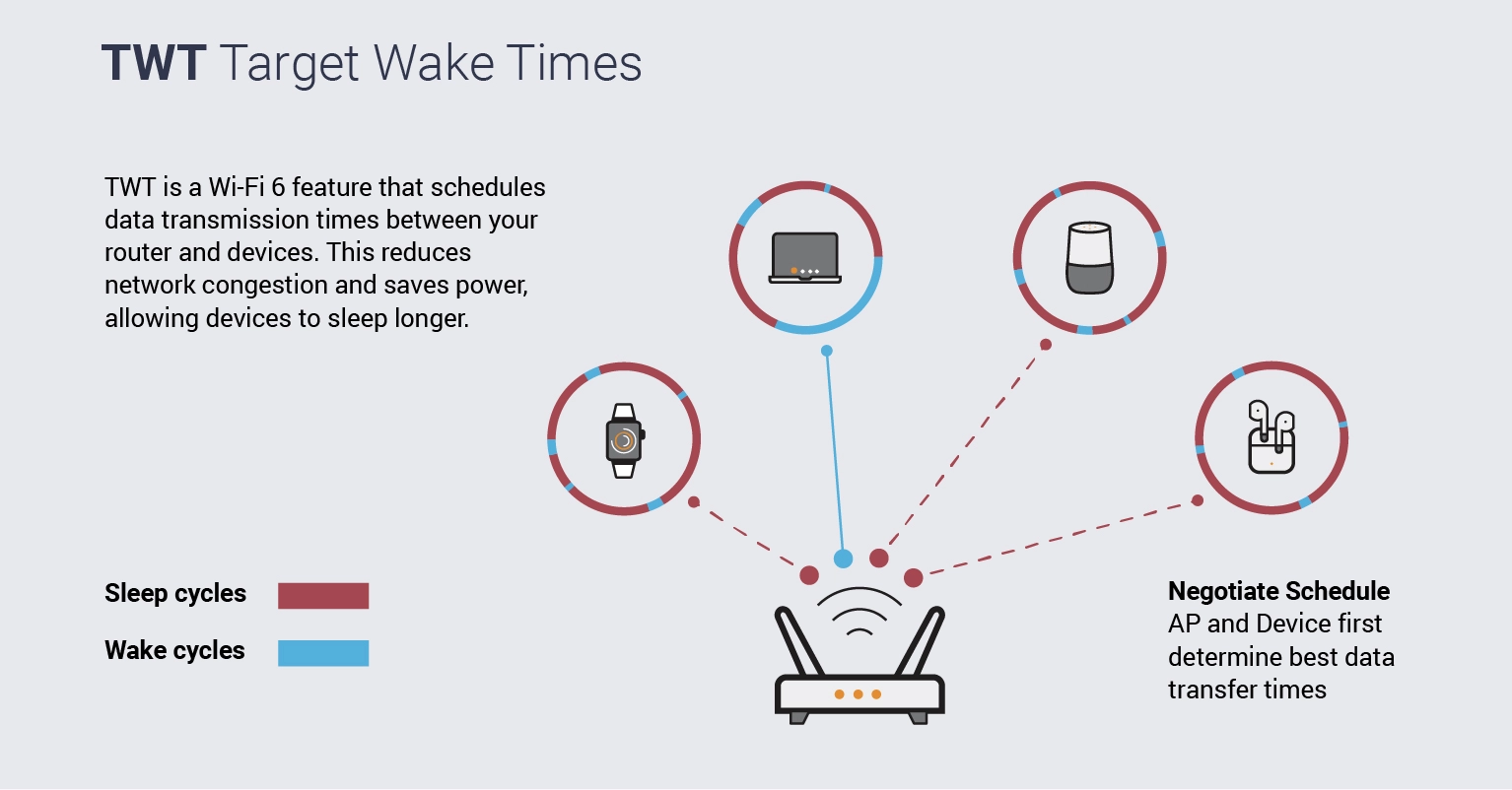
Target Wake Times (TWT): Allow for scheduled check-in times to extend battery life for power constrained IoT devices.
Managed and efficient use of bandwidth: This will conserve power. This is especially crucial if your home or business has many connected devices. A Wi-Fi 6 network can handle the increased demand much more efficiently than a Wi-Fi 5 network, making it a likely “yes” if you’re wondering, “Do I need Wi-Fi 6?”
Interference
Wi-Fi 6 reduces interference through:
Faster throughput and getting on/off the air faster, which decreases the signal traffic and collisions.
Improved bandwidth management, which reduces the RF noise.
Latency
- Another difference between Wi-Fi 5 and Wi-Fi 6 is latency. Wi-Fi 6 offers reduced latency due to:
- Faster RF data rates, which yield faster throughput.
- Efficient management of bandwidth in crowded areas (OFDMA...allowing the AP to talk to multiple STAs simultaneously).
- Improved interference performance, which reduces latency.
Improved Security with WPA3
Wi-Fi 6 also features improved security with the implementation of WPA3, offering benefits over Wi-Fi 5’s security protocols. It introduces Simultaneous Authentication of Equals (SAE) and Wi-Fi Enhanced Open Mode – Traffic encryption for open networks, providing a more secure internet connection.
Our Wi-Fi 6 Modules
While we’re on the topic of Wi-Fi 6, check out our NEW Wi-Fi 6 modules
NEW CMP9611 and CMP9612
The CMP9611 offers Wi-Fi 6 + BT5.2, while the CMP9612 is a tri-mode radio supporting Wi-Fi 6 + BT5.2 + 802.15.4. These multi-protocol modules are designed to deliver the performance and network optimization capabilities of Wi-Fi 6. They offer best-in-class range and coverage, enhancing throughput, reducing latency, decreased power consumption, and improved network reliability. Kits are available soon, so contact us for details.
Our CMP9620 Wi-Fi 6 Module
For infrastructure and larger systems requiring the highest of performance, CEL offers the CMP9620 solution. This is a Concurrent Dual-Band 2x2 MU-MIMO solution, boasting 1.2Gbps PHY and 458Mbps PHY at 5Ghz and 2.4GHz respectively. With a PCIe interface and M.2 form-factor, this is highly geared towards SBC and more integrated solutions.
Also, coming soon is a new 4x4 MU-MIMO with 160MHz channel bandwidth.
Is Wi-Fi 6 worth it?
When comparing Wi-Fi 5 vs Wi-Fi 6, it is clear that Wi-Fi 6 offers numerous advantages, including higher speeds, increased network capacity, better range, and lower latency. This makes Wi-Fi 6 an attractive option for those looking to upgrade their Wi-Fi access point or invest in the best mesh Wi-Fi 6 system.
Whether you’re wondering if you need Wi-Fi 6, want to enable MU-MIMO, or are curious about the benefits of Wi-Fi 6, this blog post should provide some valuable insights. So, how do you know if you have Wi-Fi 6? Look at the specifications of your router or access point. If it supports 802.11ax, it’s Wi-Fi 6.
From multiple access improvements to better throughput and reduced power consumption, Wi-Fi 6 technology, including its variation Wi-Fi 6E, presents a quantum leap from the previous Wi-Fi 5 (802.11ac) standard.





